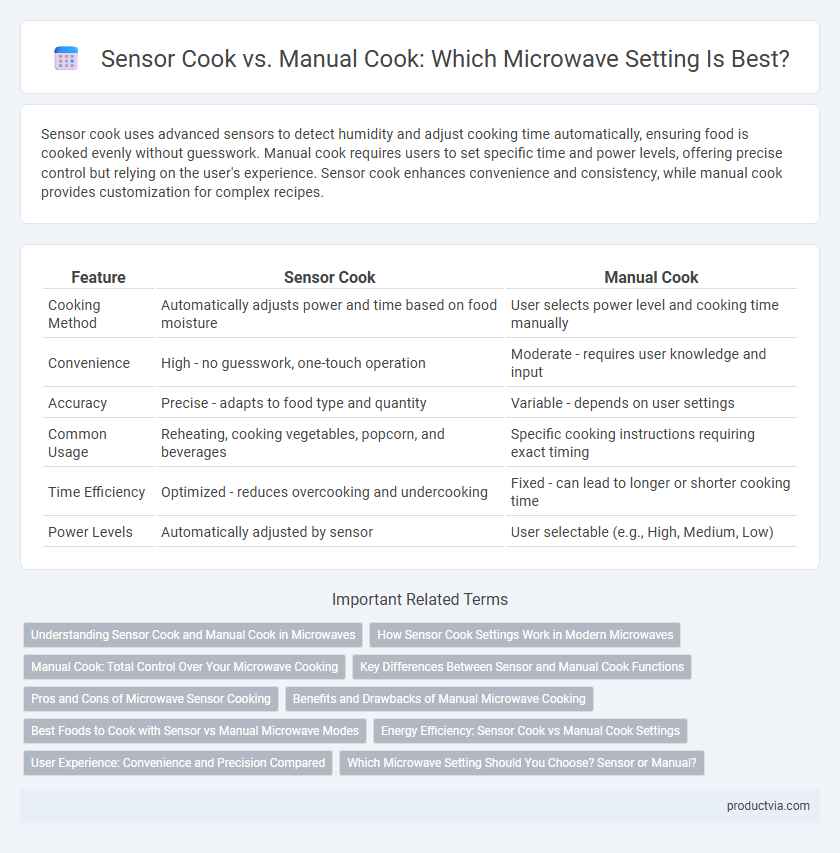Sensor cook uses advanced sensors to detect humidity and adjust cooking time automatically, ensuring food is cooked evenly without guesswork. Manual cook requires users to set specific time and power levels, offering precise control but relying on the user's experience. Sensor cook enhances convenience and consistency, while manual cook provides customization for complex recipes.
Table of Comparison
| Feature | Sensor Cook | Manual Cook |
|---|---|---|
| Cooking Method | Automatically adjusts power and time based on food moisture | User selects power level and cooking time manually |
| Convenience | High - no guesswork, one-touch operation | Moderate - requires user knowledge and input |
| Accuracy | Precise - adapts to food type and quantity | Variable - depends on user settings |
| Common Usage | Reheating, cooking vegetables, popcorn, and beverages | Specific cooking instructions requiring exact timing |
| Time Efficiency | Optimized - reduces overcooking and undercooking | Fixed - can lead to longer or shorter cooking time |
| Power Levels | Automatically adjusted by sensor | User selectable (e.g., High, Medium, Low) |
Understanding Sensor Cook and Manual Cook in Microwaves
Sensor cook in microwaves uses built-in humidity and temperature sensors to automatically adjust cooking time and power levels, ensuring perfectly cooked food without guesswork. Manual cook requires the user to set specific cooking times and power settings, offering more control but relying on trial and error for optimal results. Understanding these modes helps users choose between convenience and precision based on their cooking needs.
How Sensor Cook Settings Work in Modern Microwaves
Sensor cook settings in modern microwaves use built-in humidity and temperature sensors to detect steam emitted by the food, automatically adjusting cooking time and power levels for optimal results. These sensors enable precise cooking by measuring moisture levels, preventing overcooking or undercooking, which reduces guesswork compared to manual cook settings that rely on user-defined time and power. This technology ensures consistent energy-efficient cooking, enhancing convenience and food quality with minimal user input.
Manual Cook: Total Control Over Your Microwave Cooking
Manual cook settings on microwaves offer precise control over cooking time and power levels, enabling customized meal preparation tailored to specific food types. This method allows users to adjust cooking duration and intensity to avoid overcooking or undercooking, essential for delicate or complex dishes. Unlike sensor cook, manual cooking ensures consistent results by relying on user input rather than automatic detection.
Key Differences Between Sensor and Manual Cook Functions
Sensor cook in microwaves uses built-in humidity and temperature sensors to automatically adjust cooking time and power levels for optimal results, reducing the need for guesswork. Manual cook requires users to input specific time and power settings based on the type of food, offering greater control but demanding more attention and experience. Sensor cooking enhances convenience and accuracy, while manual cooking provides flexibility for customized recipes and cooking preferences.
Pros and Cons of Microwave Sensor Cooking
Microwave sensor cooking offers the advantage of automatically adjusting cooking time and power based on humidity and temperature levels detected inside the oven, ensuring precise results and preventing overcooking or undercooking. It eliminates the guesswork associated with manual cook settings, which require users to estimate cooking times and power levels, often leading to inconsistent outcomes. However, sensor cooking may struggle with foods that emit inconsistent steam or uneven moisture, potentially resulting in inaccurate timing, whereas manual cooking provides full control but demands experience and attention from the user.
Benefits and Drawbacks of Manual Microwave Cooking
Manual microwave cooking offers precise control over cooking time and power level, allowing users to tailor settings for specific recipes and preferences. However, it requires users to have a good understanding of cooking times and power settings, increasing the risk of undercooking or overcooking food. Unlike sensor cook functions, manual settings do not automatically adjust for moisture or temperature, which can lead to inconsistent results and more frequent monitoring.
Best Foods to Cook with Sensor vs Manual Microwave Modes
Sensor cook modes in microwaves excel at preparing foods with varying moisture content such as vegetables, fish, and leftovers by automatically adjusting cooking time and power for optimal results. Manual cook settings are ideal for precise control when cooking specific items like popcorn, frozen meals, or defrosting meat, where exact timing and power level adjustments are necessary. Choosing sensor cook enhances convenience and reduces overcooking for moisture-sensitive foods, while manual mode delivers better results for recipes requiring customized heat application.
Energy Efficiency: Sensor Cook vs Manual Cook Settings
Sensor cook settings in microwaves detect moisture and adjust cooking time automatically, significantly reducing energy consumption by preventing overcooking. Manual cook settings often rely on preset times, which can lead to unnecessary energy use due to guesswork or user error. Utilizing sensor cook technology optimizes power usage, promoting greater energy efficiency compared to manual cooking modes.
User Experience: Convenience and Precision Compared
Sensor cook technology in microwaves enhances convenience by automatically adjusting cooking time and power based on the food's moisture and temperature levels, reducing guesswork and preventing overcooking. Manual cook settings offer precision for users who prefer control over time and power, but require experience to achieve consistent results. Overall, sensor cooking improves user experience through effortless operation and optimized cooking outcomes, while manual settings cater to expert users seeking exact customization.
Which Microwave Setting Should You Choose? Sensor or Manual?
Sensor cook in microwaves automatically adjusts cooking time and power based on humidity and temperature detected, ensuring optimal results without guesswork. Manual cook offers full control over time and power level, ideal for users who prefer specific cooking adjustments or reheating exact portions. Sensor cook is best for convenience and precision, while manual cook suits those prioritizing customization and exact control.
Sensor cook vs Manual cook for microwave settings Infographic

 productvia.com
productvia.com